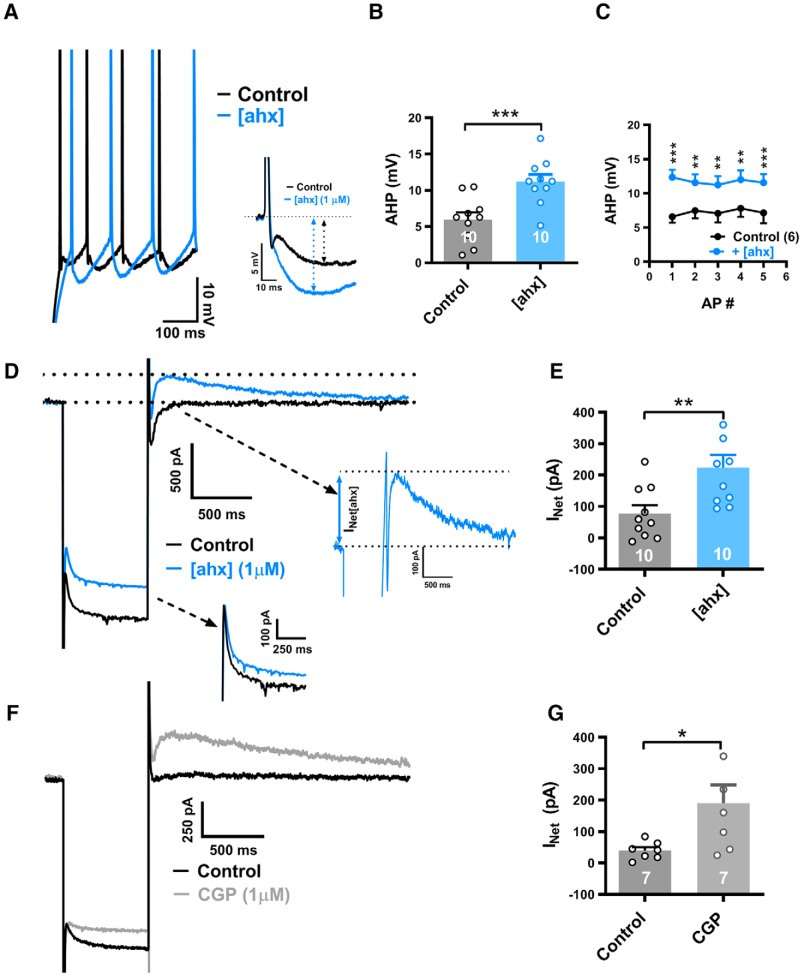Figure 9.
[ahx5–24]NPY increases the AHP in a subset of PNs. A, Left, Superimposed AP trains (current step-evoked) from a cell where [ahx5–24]NPY (1 μm; blue) enhanced the AP AHP seen in control (black). Similar numbers of step-evoked APs were compared in control and in [ahx5–24]NPY: here 8 and 7 Aps, respectively. Right, The first step-evoked AP from the above traces expanded and aligned, illustrating the substantial AHP enhancement. B, AHP amplitudes of initial APs in control and in [ahx5–24]NPY (1 μm). In 10 of 21 PNs tested, the Y2R agonist significantly increased the first AHP from 5.97 ± 1.00 to 11.19 ± 1.13 mV (t(9) = 8.709; p < 0.0001; n = 10 cells, 8 rats; Student's paired t test). C, Amplitudes of the first 5 AHPs in a train evoked in control and in [ahx5–24]NPY (1 μm) (two-way repeated-measures ANOVA; treatment: F(1,25) = 109.2, p < 0.0001; voltage: F(4,25) = 0.05778, p = 0.9934; interaction: F(4,24) = 0.5242, p < 0.7189; n = 6 cells, 5 rats). AP amplitudes were significantly increased by the Y2R agonist as indicated (Bonferroni's post-test). Four further PNs, which responded to [ahx5–24]NPY with a >30% enhancement of the first AHP, were excluded because they failed to fire 5 successive APs following Y2R agonist treatment (regardless of increasing step amplitude). D, Current responses to a hyperpolarizing voltage-clamp step (−55 to −135 mV) from a PN in which [ahx5–24]NPY (1 μm; blue) enhanced AHP amplitude seen in control (black), as in A. Following Y2R agonist treatment, a slowly decaying “rebound” outward current (visible at the end of the hyperpolarizing step) was substantially enhanced. Inset, Right, The expanded view (blue) illustrates this outward current's characteristic slow decay and preceding inward current. Inset, Bottom right, Only a modest effect on Ih was seen. E, Rebound outward current peak amplitudes from PNs whose first AHP was increased (>30%) in response to the Y2R agonist. In such neurons, [ahx5–24]NPY (1 μm) significantly increased this outward current from 77.5 ± 26.4 to 223.8 ± 47.8 pA (t(9) = 4.094; p = 0.0027; n = 10 cells, 8 rats; Student's paired t test). In PNs where [ahx5–24]NPY (1 μm) decreased the KIR, but did enhance the AHP, this outward current was not significantly changed [28.8 ± 13.8 pA (control) to 37.9 ± 19.5 pA (Y2R); t(10) = 1.246; p = 0.2413; n = 11 cells, 7 rats; Student's paired t test] (not illustrated). F, Current responses to a hyperpolarizing voltage-clamp step (−55 to −135 mV) from a PN in which the GABABR antagonist CGP 52432 (1 μm; gray) enhanced AHP amplitude relative to control (black), similar to effects of the Y2R agonist. Following GABABR blockade, a slowly decaying outward rebound current (visible upon returning to −55 from −135 mV) is substantially enhanced. G, Rebound outward current peak amplitudes from PNs where the GABABR antagonist increased the first AHP (>30%). In AHP-responsive PNs, CGP 52432 (1 μm) significantly increased this outward current from 39.5 ± 28.1 to 190.6 ± 58.1 pA (t(6) = 2.735; p = 0.0340; n = 7 cells, 5 rats; Student's paired t test). *p < 0.05, **p < 0.01, ***p < 0.001.

